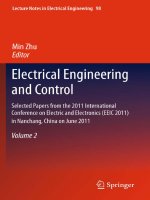Lecture Electrical Engineering: Lecture 8 - Dr. Nasim Zafar
Bạn đang xem bản rút gọn của tài liệu. Xem và tải ngay bản đầy đủ của tài liệu tại đây (971.4 KB, 33 trang )
COMSATS Institute of Information Technology
Virtual campus
Islamabad
Dr. Nasim Zafar
Electronics 1
EEE 231 – BS Electrical Engineering
Fall Semester – 2012
Junction Break Down
Lecture No: 8
v
Breakdown Characteristics
* Zener Breakdown
* Avalanche Breakdown
Kwangwoon
University
Semiconductor device lab.
Semiconductor Devices.
Introduction:
•
•
Under normal operation of a diode, an applied reverse bias
(voltage) will result in a small current flow through the
device.
However, at a particular high voltage, which is called
breakdown voltage VBD, large currents start to flow. If
there is no current limiting resistor, which is connected in
series to the diode, the diode will be destroyed. There are
two physical effects which cause this breakdown.
Breakdown Mechanism:
•
•
Zener Effect
Ø
Occurs in heavily doping semiconductor
Ø
Breakdown voltage is less than 5V
Ø
Carriers generated by electric fieldfield ionization
Ø
TC is negative
Avalanche Effect
Ø
Occurs in slightly doping semiconductor
Ø
Breakdown voltage is more than 7V
Ø
4
PN Junction Under ForwardBias Condition:
Ø
Ø
The pn junction
excited by a constant
current source
supplying a current I in
the forward direction.
The depletion layer
narrows and the barrier
voltage decreases by V
volts, which appears as
an external voltage in
the forward direction.
5
PN Junction Under ReverseBias Condition:
Ø
Ø
Ø
Nasim Zafar
The pn junction excited by
a constantcurrent source I
in the reverse direction.
To avoid breakdown, I is
kept smaller than IS.
Note that the depletion
layer widens and the barrier
voltage increases by VR
volts, which appears
between the terminals as a
reverse voltage.
5
IV Characteristic of a PN Junction:
As the reverse bias voltage increases, the electric
field in the depletion region increases. Eventually, it
can become large enough to cause the junction to
break down so that a large reverse current flows:
breakdown voltage
IV Characteristic of a PN Junction:
Current increases exponentially with applied forward
bias voltage, and “saturates” at a relatively small
negative current level for reverse bias voltages.
“Ideal diode” equation:
ID
IS
I S eVD / VT 1
AJ S
Dn
Aqn
N A Ln
2
i
Dp
N D Lp
PN Junction Under ReverseBias Condition:
IV characteristic equation:
i
Is
Independent of voltage
Where Is is the saturation current, it is proportional to ni2
which is a strong function of temperature.
D p pn 0 Dn n p 0
I s qA(
)
Lp
Ln
Dp
2
qAni (
L p nD
Nasim Zafar
Dn
)
Ln n A
6
Breakdown Voltage VBD
One can determine which mechanism is responsible for the
breakdown based on the value of the breakdown voltage VBD :
v VBD < 5 V Tunneling Breakdown
v VBD > 6V Avalanche Breakdown
v 4V < VBD < 6V both tunneling and
avalanche mechanisms are responsible
Energy Band Diagram of a PN Junction
W
EC
qV
E Fp
EV
E Fn
Origin of Current Flow
Reverse bias:
Forward bias:
W
EC
Ln
q Vbi V
qV
E Fp
EC
E Fn
qV
q Vbi
E Fp
EV
V
E Fn
EV
Lp
W
Reverse saturation current is due
to minority carriers being collected
over a distance of the order of the
diffusion length.
Reverse Saturation Current
The flow of these minorities produces the reverse saturation
current but it is independent of applied reverse voltage.
I(current)
Forward Bias
Vb
I0
V(voltage)
VB ; Breakdown voltage
I0 ; Reverse saturation current
Reverse Bias
Drift current
Ideal Diode IV characteristic
Real Diode IV characteristic
Real Diode – Reverse Current
What’s wrong with this picture?
Reverse Bias:
–
Current ~103 times larger than FB I0
–
Reverse current doesn’t saturate
–
Breakdown – large current above VBbd
Avalanche Breakdown
Avalanche Breakdown:
•
Avalanche breakdown mechanism occurs when
electrons and holes moving through the depletion region
of a reverse biased PN junction, acquire sufficient
energy from the electric field to break a bonds i.e. create
electronhole pairs by colliding with atomic electrons
within the depletion region. The electric field in the
depletion region of a diode can be very high.
•
The newly created electrons and holes move in
opposite directions due to the electric field present
within the depletion region and thereby add to the
existing reverse bias current. This is the most
important breakdown mechanism in PN junction.
Avalanche Breakdown
v
Impact Ionization Mechanism
Mechanism
In(w) = M *
Ino
Total current during
avalanche multiplication
Energy Band diagram; Avalanche Breakdown:
Depletion width larger
than mean free path
lots of collisions
Junction BuiltIn Voltage:
The Junction BuiltIn Voltage is given as:
Vo
N AND
VT ln
2
ni
Ø It depends on doping concentration and
temperature
Ø Its TC is negative.
22
Junction Parameters:
Vbi
Ec
VA
VBR
VBR
N A ND
2q
KS 0 NA
ND
2
VBR
VBR
Vbi
1
NB
NA
ND
N A ND
One-sided junctions
VBR
Current Density of an Avalanche Process:
Jn
Jp
dx
Jn
n J n dx
Jp
n J n dx
Impact ionization initiated by electrons.
Jn
Jp
p J p dx
dx
Jn
p J p dx
Jp
Impact ionization initiated by holes.
dJ p
dJ n
0,
dx
dx
dJ p
dJ n
dx
dx
J
Jn
Jp
0
const.
Multiplication factors for
electrons and holes:
Mn
J n (W )
, M p
J n ( 0)
J p ( 0)
J p (W )
Zener Breakdown









